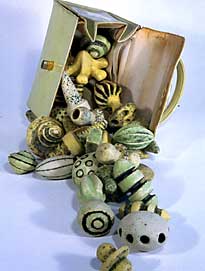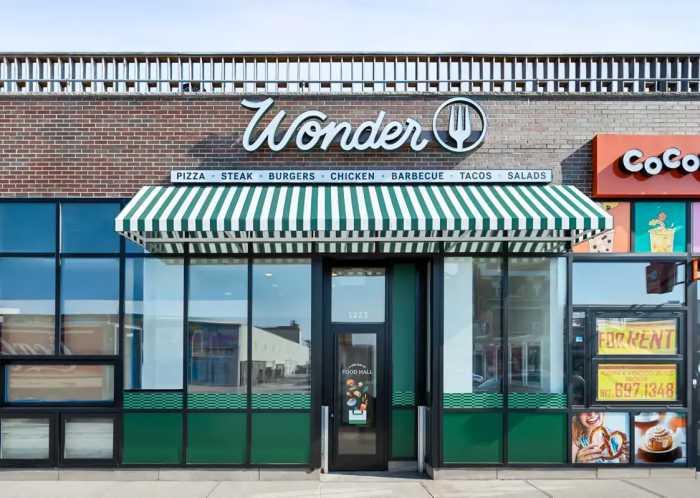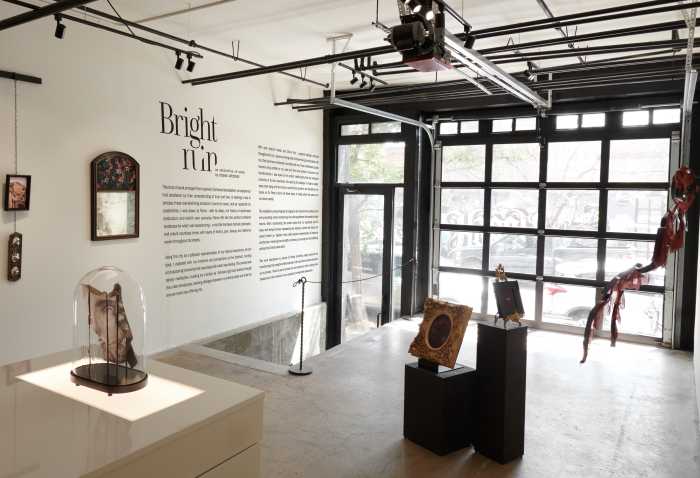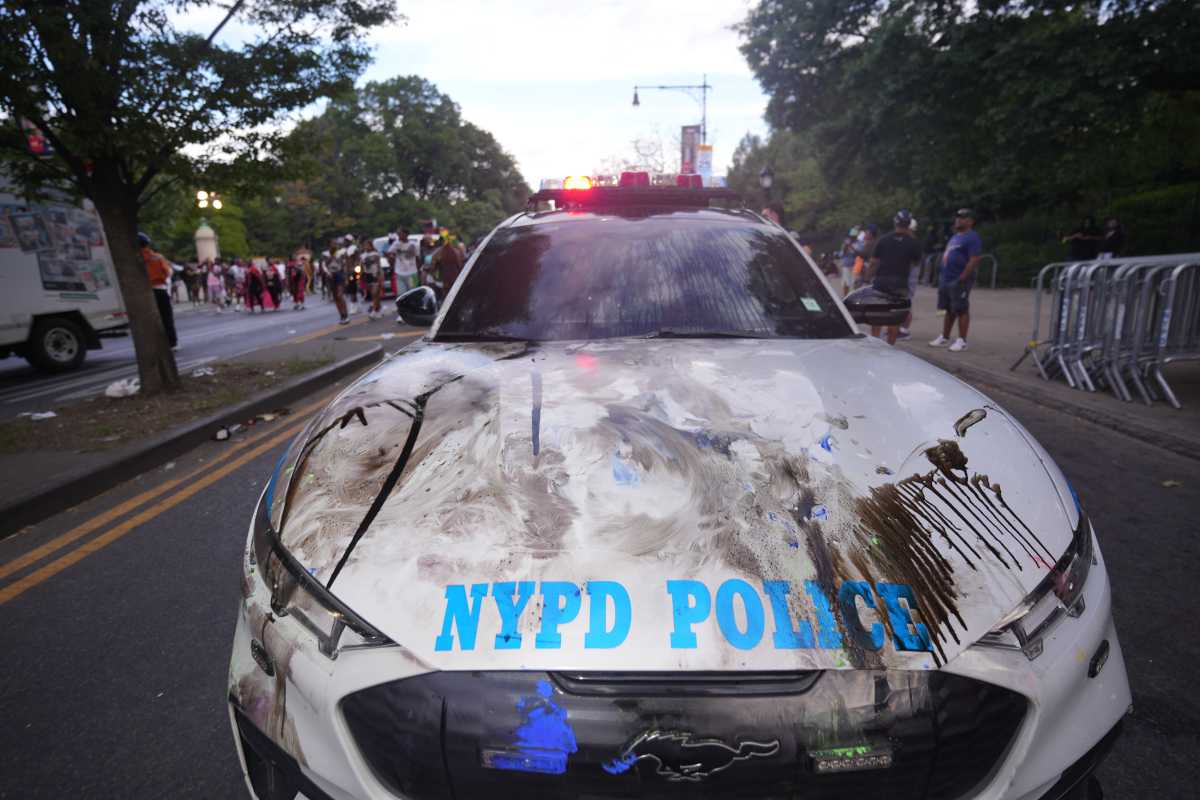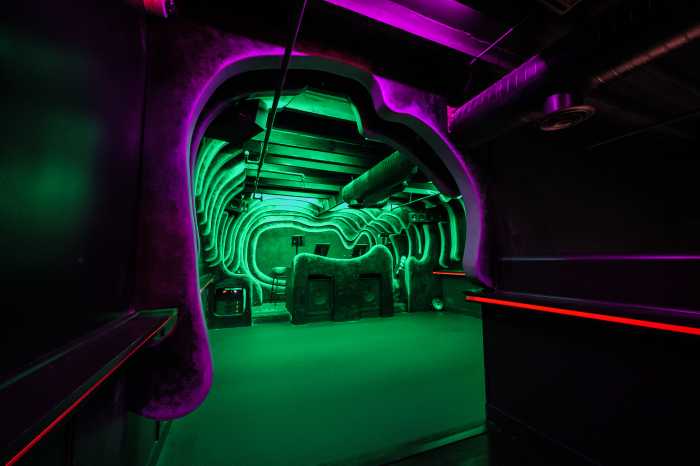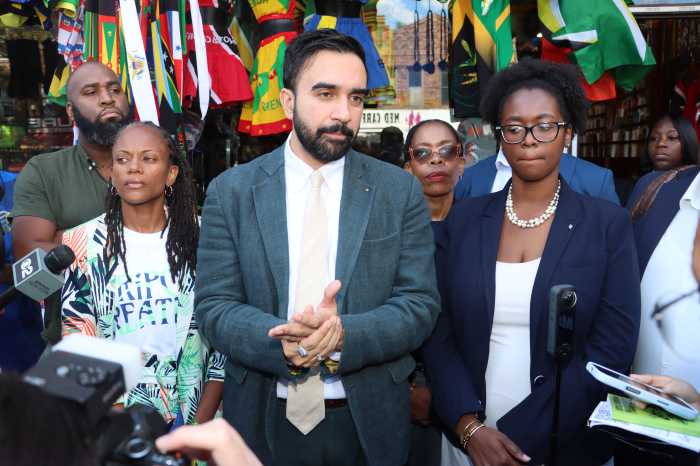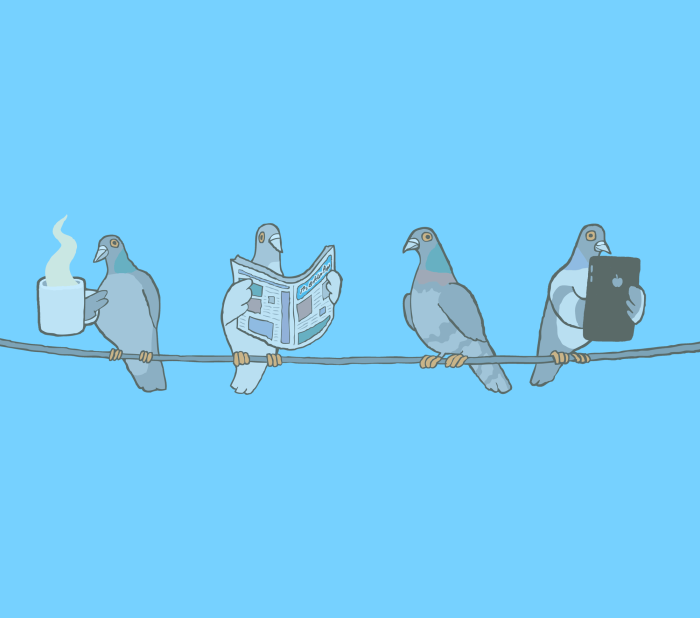"What happened in Lime Mills?,"
a new art exhibit at The Rotunda Gallery in Brooklyn Heights,
could just as easily be called "You can’t escape death."
The show of paintings, sculptures, drawings and photographs is
a headlong dive into those things that unnerve you and over which
you have no control: disease, death and decay.
Guest curator Nelly Reifler said she compiled this show, featuring
the works of 12 Brooklyn artists, with the theme being a nameless
epidemic invading a fictional town, and all of the repercussions
that come with it. "This [exhibit] gives us space to think
about illness without the politically charged, historically embedded,
culturally specific aspects that a show about AIDS or breast
cancer, or anthrax or the Black Death would necessarily have,"
Reifler explains.
Reifler, co-editor with Paul Auster of the anthology "I
Thought My Father Was God and other True Tales from NPR’s National
Story Project" (Henry Holt & Company, 2001), inserts
bits of fiction intermittently throughout the show, adding a
provocative variable to the usual gallery show formula.
She is asking the viewer to look at the works – constructed in
different years in a variety of media – in the context of disease.
She has brought together an impressive amount of talent, and
yet one feels this exercise – of putting the works in a fearsome
context – lends them a poignancy and eeriness that they may not
have otherwise had.
For instance, Carola Dreidemi’s "Unrest – The Run"
(1998) and Edward Coppola’s "Running the Gauntlet"
(1999-2001) both feature desperate figures outrunning danger.
In this context we’re to assume they are outrunning a disease,
a harrowing endeavor. "Unrest" is an 8-mm film transferred
to video. The black-and-white film loop follows a woman in white
desperately running and flailing, never arriving at a destination.
The film is hand-colored with a hectic desperate flashing red,
warning of danger and heightening the hysteria.
Coppola’s "Gauntlet" is no ordinary racecourse. His
large diorama features a golden figure, also a woman, already
maimed, appearing to run from a giant circular saw blade through
a painted, sculpted field of treacherous needle points and into
a large hand. A dove looks down on the scene from its perch on
a cloud, possibly – like the hand – a Christian symbol. Somehow
Coppola’s work, with the white bird watching, seems not as terrifying
as Dreidemi’s, in which the woman is so utterly alone.
Artist Maggie Tobin brings a much more obvious, gothic sensibility
to her work. Her paintings on goatskin, covered with human ashes
and breast milk, take the examination of the decay of the body
to an entirely new level. Mixing the ashes of her mother with
her own breast milk, Tobin may be attempting to address regeneration
and renewal, but the gloomy tone of her paintings, such as a
full moon surrounded by dark blue clouds and "Road Home"
– a path through a forest – come across as naïve works.
Despite the disturbing media in which she’s working, the subject
matter falls flat.
Both Josh Dorman’s "Edna’s Pool" (2000) and Joan Snyder’s
"Orchard" (1995) are canvases with square voids. In
the context of this exhibit, they hint of the humans now absent
and unknowing, uncaring nature which continues to thrive. "Edna’s
Pool" is an embroidered canvas dominated by a large, empty
square surrounded by leafless trees. But one artist’s empty pool
is this curator’s grave. Same for Snyder’s painterly "Orchard."
There are dark-brown swaths of decay in her field dotted with
pretty, red swirls. White rectangles pop up intermittently across
the canvas – bits of order in the chaos of nature. But in the
context of this show, they’re tombstones.
Lost hair is often a sign of grave illness and the symbol arrives
literally in Hunju Park’s untitled paintings (2001). In one,
the canvas is saturated with black ink and black, human hair
is glued to it. The smooth heads of silver nails converge into
a larger, smooth shape emerging from the tangle of hair like
a breaching whale. This symbol is employed again in Elizabeth
Albert’s "Whisker" (2001) in which a new (mutant?)
twig of hair grows out of roiling pink sea, in the midst of the
taller, thicker forest of hairs. Albert’s painting is flat and
fantastic – many steps removed from the literal, found object
approach of Park’s work, yet both works point to the unruly nature
of the human body.
Finally, the cold objectivity of science – upon which we rely
for any hope of a cure – is addressed in Madelon Galland’s "Biopsy"
(1997) and even more so in her "Imposters" (1999) in
which a prone, oval shape has tubing run through it, and magnifying
glasses are positioned over it. Her "Biopsy," in which
ceramic shapes like a pacifier and rattle spill from a vinyl
handbag, reminds us that this woman is probably someone’s mother
and that bad news from her biopsy would have painful repercussions
to those she has nurtured.
David Landow’s "Fleshapoids" (2000), drawings of fantastic
micro-organisms, are underscored by Reifler’s text, "The
specialist almost gasped at what he saw – not from horror, exactly,
but from admiration. (The two aren’t as far apart as you think.)
This was an organism of great beauty "
The isolation that comes with being ill, and more importantly,
the tragedy of an ill child, is addressed in Barbara Reiser’s
"Possible Child’s Sick Room, Lime Mills" (2001). Faceless
outlines of children and bears and bunnies decorate three walls,
while a fourth wall has over 30 outlines of small birds. Reiser’s
work was the only one created "specifically for ’What Happened
in Lime Mills,’" according to Reifler.
Overall, "What happened in Lime Mills?" is an interesting
concept for a gallery show. By asking the viewer to accept a
certain storyline as a premise for examining the artwork, the
works open up to new and different interpretations. Possibly
these meanings are different than those the artists intended,
but it is true that beauty – and meaning – are always in the
eye of the beholder.
"What happened in Lime Mills"
will be on display at The Rotunda Gallery [33 Clinton St. at
Pierrepont Street, (718) 875-4047] through March 9. Admission
is free. For more information, visit www.brooklynX.org/rotunda
on the Web.


